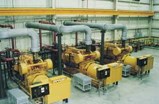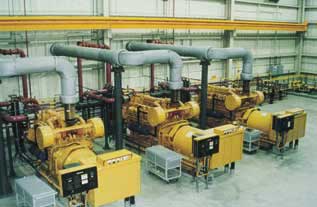Cat gen sets boost power for remote Canadian town

To ensure a remote community gets adequate electrical power with room to grow, Canadian power utility Manitoba Hydro recently installed a new diesel-generating powerhouse in Brochet, Manitoba. The new powerhouse produces 2.6 MW of prime power generated from three Caterpillar electronically controlled generator sets, said Warren Gogol, Manitoba Hydro engineering staff officer.
Responding to community developments in Brochet, which is in northwest Manitoba and has a population of 830, Manitoba Hydro designed the powerhouse with future expansion capabilities planned, replacing the former 1175 kW plant. To reduce noise, Manitoba Hydro moved the plant farther away from the town, but closer to the airport for convenient access to emergency shipments of tools, fuel or other supplies, Gogol said.

Electronically controlled Caterpillar gen sets used by Manitoba Hydro to supply 2.6 MW of prime power to the small, but growing town of Brochet.
"The powerhouse incorporates a newer design and high technology equipment that will bring Brochet residents a higher quality of service as the community grows," he said. "Among the tenders, Caterpillar was able to provide the most reliable, cost-effective generating equipment needed for the installation."
New technology powers a community
Installed in August 1999, the powerhouse uses two Caterpillar 3512B generator sets, each rated 1015 kW at 1200 rpm, and one 3508B gen set, rated 600 kW at 1200 rpm. The electronically controlled gen sets run based on load demands determined by daily and seasonal energy use cycles.
The gen sets and switchgear for auto paralleling and synchronization came from local Caterpillar dealer Powell Equipment Limited (Winnipeg, Manitoba). Manitoba Hydro, Gogel said, supplied the remote control and monitoring equipment.
The plant also uses a Caterpillar 250 kW standby unit that restores plant lighting, battery back-up and block heaters in the event of a complete shutdown, he said.
The powerhouse also uses a diesel fuel tank farm, which consists of 30, 13,210-gal fuel tanks, with a total capacity of about 400,000 gallons of diesel fuel, a two-year supply. Fuel shipments come once a year by truck via the winter road, the sole thoroughfare to the plant. Most freight shipments for the community, Gogel said, follow that route, which usually remains open from late January to the end of March.
Manitoba Hydro installed all of the equipment. And Caterpillar field engineering and Manitoba Hydro engineers participated during testing and commissioning before the generating station switched over for community service.
Fuel efficiency became a key factor leading to Caterpillar's selection, Gogol said. Manitoba Hydro conducted a 10-year life cycle analysis between the Cat gen sets rated 1800 rpm and 1200 rpm against competitive packages. The analysis indicated that the Caterpillar 3500 Series B gen sets, rated 1200 rpm, would consume less fuel and require less frequent maintenance with 30,000-hour overhaul intervals than any other comparable gen sets.
According to Richard Warsza, Manitoba Hydro engineer, another key consideration for selecting Caterpillar equipment involved receiving a complete package from a single manufacturer. In the past, Warsza said, generators were often equipped with controls supplied by multiple manufacturers.
"Having a complete package from Caterpillar simplified the installation, commission and testing of the gen sets," he said. "In fact, it streamlined the process so much that it saved our technicians a week's worth of testing."
Edited by April C. Murelio
editor@poweronline
